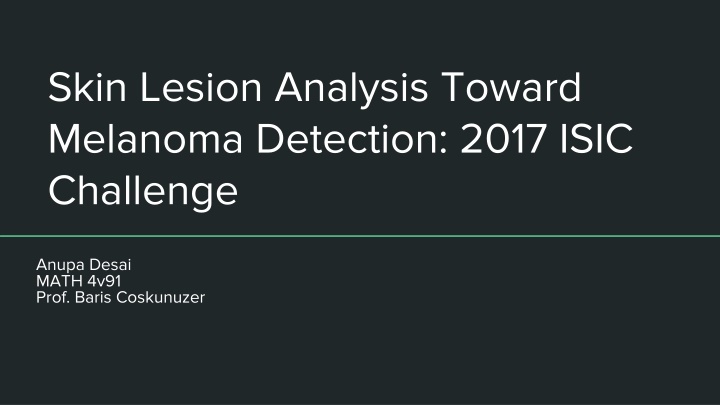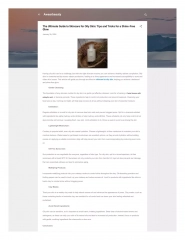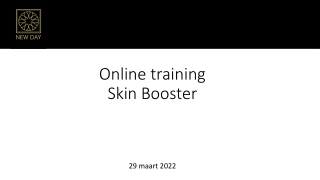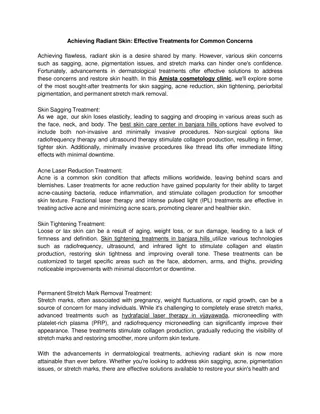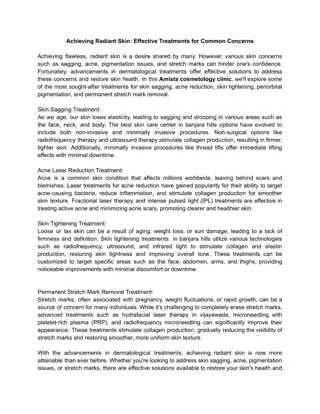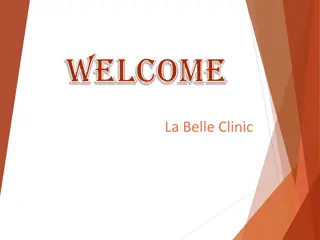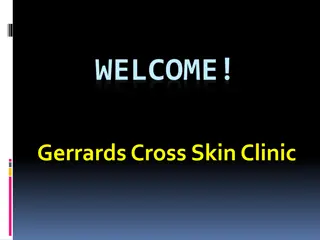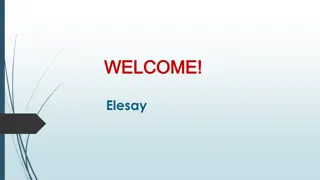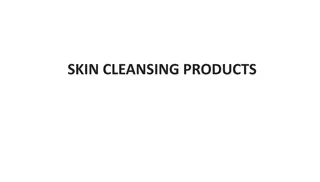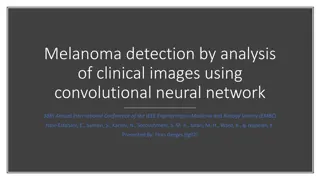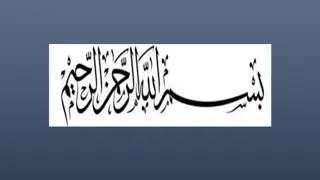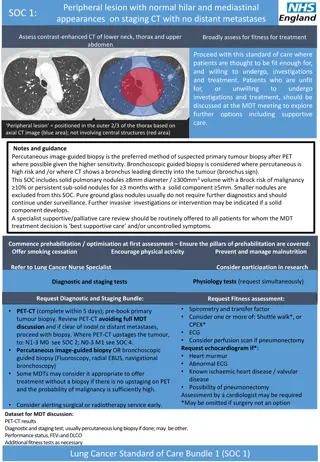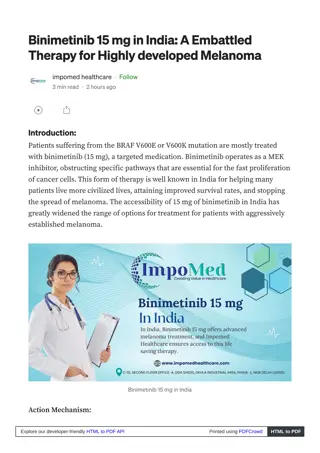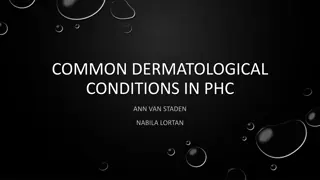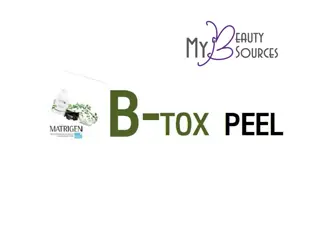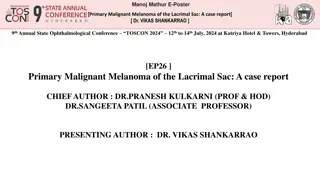Skin Lesion Analysis Toward Melanoma Detection: ISIC Challenge
This study focuses on the 2017 ISIC Challenge for melanoma detection, aiming to improve automated inspection of dermatoscopic images in the diagnosis of skin cancer. The dataset comprises 2000 images, with a task involving binary and three-label classification techniques on a variety of skin lesion types. Methods include preprocessing, grayscale conversion, persistence diagrams, vectorization, and training with a Random Forest Classifier.
Download Presentation

Please find below an Image/Link to download the presentation.
The content on the website is provided AS IS for your information and personal use only. It may not be sold, licensed, or shared on other websites without obtaining consent from the author.If you encounter any issues during the download, it is possible that the publisher has removed the file from their server.
You are allowed to download the files provided on this website for personal or commercial use, subject to the condition that they are used lawfully. All files are the property of their respective owners.
The content on the website is provided AS IS for your information and personal use only. It may not be sold, licensed, or shared on other websites without obtaining consent from the author.
E N D
Presentation Transcript
Skin Lesion Analysis Toward Melanoma Detection: 2017 ISIC Challenge Anupa Desai MATH 4v91 Prof. Baris Coskunuzer
Motivation Most prevalent form of cancer in the US is skin cancer Melanoma- the most dangerous type - 9000 deaths/year[1] Diagnostic accuracy of unaided expert inspection is ~ 60%[2] With dermoscopy, diagnostic accuracy is 75% - 84%[2 3] Reports indicate a growing shortage of dermatologists per capita[4] Increased need and interest in techniques for automated inspection of dermoscopic images
What is ISIC challenge? A challenge at the International Symposium for Biomedical Imaging (ISBI), hosted by International Skin Imaging Collaboration (ISIC) The 2017 challenge has 3 parts and participants could choose to participate in any/all of the 3 parts: 1. Skin Lesion Segmentation - prediction of lesion segmentation boundaries 2. Detection and Localization of Visual Dermoscopic features - prediction of dermoscopic features - used by expert dermatologists to evaluate skin lesions 3. Disease Classification - binary classification of (i) melanoma and (ii) nevus and Seborrheic Keratosis & (i) Seborrheic Keratosis and (ii) nevus and Melanoma
My Dataset 2017 challenge 2000 Images - training set: 1371 Normal Images 374 Melanoma 255 Seborrheic Keratosis My task: trying 2 classification techniques: 100 Normal and 100 Melanoma (Binary classification) 100 Normal, 100 Melanoma and 100 Seborrheic Keratosis (3-label classification) Image size: Variable, ranging from 767 x 767 to 4400 x 6700
Methods 1. Preprocessing: loading data into my code 3 kind of files: csv, png and jpg - kept jpg and deleted the rest Sorting them into their respective folders using the excel sheet provided 1. Grayscaling: After resizing images to 750 by 750, I converted each image to grayscale using imread imread - float values of image in [-1,1] Normalized it to the range [0, 255]
3. Persistence diagram: Supplied each image grayscale value to the cubical persistence function from giotto tda, for homology dimension 0 4. Vectorization: Betti functions with n_bins = 150 Silhouette with p = 1 5. Training the model using Random Forest Classifier
Melanoma Images Normal Images
Results Binary Classification (100 Melanoma and 100 Normal) Vectorization AUC Accuracy Betti_0 0.675 0.648 Silhouette for p = 1 0.603 0.575 3-label Classification (100 Normal, 100 Melanoma and 100 Seborrheic Keratosis) Vectorization AUC Accuracy Betti_0 0.52 0.498
Team Approach AUC Accuracy Casio and Shinshu University Joint ResNet ensemble with with normalized images 0.911 0.816 Recod titans: 10% horizontal and vertical shifts, 20% zoom and 270 degrees rotation of images, with 128 x 128 image size Multimedia Processing group - Universidad Carlos III de Madrid Gpm - LSSSD 0.910 0.883 All of the competitors listed used 2000 images for training release (rc36xtrm) "alea jacta est" RECOD Titans/ UNICAMP 0.908 0.883 EResNet(single scale w/o attributes USYD - BMIT 0.896 0.888 ISIC 2017 Challenge leaderboard MyBrainAl Yale 0.705 0.803
What could have been done better Decrease the size of each image by the same amount Remove outliers Instead of directly converting grayscale images to persistence diagrams, could have first converted grayscale to a binary image radial filtration cubical persistence Increase the number of images I have
References [1] Cancer Facts & Figures 2017 . American Cancer Society, 2017. Available: https://www.cancer.org/research/cancer-factsstatistics/all-cancer-facts- figures/cancer-facts-figures2017.html [2] Siegel, R.L., Miller, K.D., and Jemal, A.: Cancer statistics, 2017, CA: A Cancer Journal for Clinicians, vol. 67, no. 1, pp. 7-30. 2017. [3] Kittler, H., Pehamberger, H., Wolff, K., Binder, M.: Diagnostic accuracy of dermoscopy . The Lancet Oncology. vol. 3, no. 3, pp. 159-165. 2002. [4] Kimball, A.B., Resneck, J.S. Jr.: The US dermatology workforce: a specialty remains in shortage. J Am Acad Dermatol. vol. 59, no. 5, pp. 741-5. 2008.
